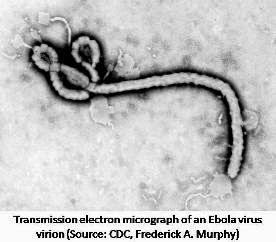
In March 2014, the Ministry of Health of Guinea notified WHO of a rapidly evolving outbreak of Ebola virus disease in forested areas of south-eastern Guinea. As of 22 March 2014, 49 cases including 29 deaths (case fatality ratio: 59%) had been reported. The disease later spread to the neighbouring countries of Liberia and Sierra Leone. It recently spread to Nigeria through a traveller from Liberia. Between 12 and 13 August 2014, a total of 152 new cases of Ebola virus disease (laboratory-confirmed, probable, and suspect cases) as well as 76 deaths were reported from Guinea, Liberia, Nigeria and Sierra Leone. As of 13 August 2014, total 2127 cases, including 1310 confirmed, 594 probable, and 223 suspect cases of Ebola virus disease have been recorded in Guinea, Liberia, Nigeria, and Sierra Leone resulting in 1145 human deaths.
The disease (previously known as Ebola haemorrhagic fever) is a severe zoonotic and often fatal disease that affects humans and nonhuman primates. It got its name because it was first recognized in a village situated near Ebola River in the Democratic Republic of the Congo (formerly Zaire) in Africa. Since its initial recognition in 1976, the disease outbreaks have been recorded in Africa. These are usually associated with very high case fatality rates up to 90%. The disease is caused by Ebolavirus. Current evidence suggests that fruit bats of the Pteropodidae family are the natural host for ebolaviruses. The virus is transmitted to people from wild animals (primates) and once the virus has entered the population, it can spread from person to person. Ebola virus disease outbreaks can devastate families and communities, but the infection can be controlled through the use of recommended protective measures in clinics and hospitals, at community gatherings, or at home. WHO recommends standard precautions in the care and treatment of all patients regardless of their perceived or confirmed infectious status. They include the basic level of infection control - hand hygiene, use of personal protective equipment to avoid direct contact with blood and body fluids, prevention of needle stick and injuries from other sharp instruments, and a set of environmental controls.